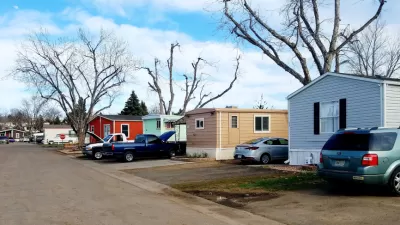Angela Kaufman purchased what she thought would be her longtime home in a mobile home community. Less than a year after she moved, the park was sold and residents were told they had to go.

The sun glitters on the blue waters of Saratoga Lake in upstate New York and refracts off the lines of bright white boats docked at a nearby boat launch and marina. The lake is located near Saratoga Springs, a longtime tourist destination in eastern Saratoga County that’s filled with all the hallmarks of a high-end vacation paradise—5-star hotels, a casino, golf course, racetrack, multiple entertainment venues, and the expensive and exclusive Prime Steak House. But luxury and scenery don’t convey a complete picture of the area.
Income inequality is stark in Saratoga County, so stark in fact that studies have put it on par with San Francisco and Manhattan. The Economic Policy Institute ranked the county 28th in income inequality out of 3,000 U.S. counties.
With such a difference in household incomes, and the rising cost of housing in the area, it isn’t surprising that Saratoga County is also home to the most mobile home parks in the entire state.
The Saratoga Lakeview Mobile Home Park, which lies adjacent to Saratoga Lake, is one such community. It’s where Angela Kaufman moved a few years ago in hopes of finding an affordable home for the long term. But things haven’t worked out as planned. The property changed ownership not too long after Kaufman moved in, and ever since, she says she’s been fighting to keep her home in the face of escalating harassment.
Kaufman’s story highlights a loophole in provisions that are supposed to protect mobile home park residents, as well as the power of park owners to make life difficult for tenants in technically legal ways.
‘We Thought We Were Doing the Right Thing’
Kaufman moved into Saratoga Lakeview Mobile Home Park in 2020 with her partner and two rescue dogs. It was there that she hoped to find some peace to recover from a brain injury and ride out the pandemic.
“My partner was not working at the time,” she recalls. “I am self-employed, my health was starting to deteriorate.” Their rent of $1,030 a month in the neighboring town of Clifton Park was going up regularly, and wealthy people were moving into the area from New York City. Knowing they were going to be priced out before long, they started looking at mobile homes.
Manufactured homes are one of the most common forms of unsubsidized affordable housing, especially in less urban areas. In a mobile home park, purchasers buy the physical homes, but pay lot rent to the owner of the land on which the home sits. Park owners are responsible for infrastructure and maintenance of common areas.
Kaufman and her partner looked at parks for a few months and even held off on making an offer on a home in another park because Kaufman’s partner had had a good experience with the then-owner of Lakeview, who had a reputation for being reasonable and hands-off with tenants. Lakeview was home to 14 households, including families with young kids, elderly folks with chronic diseases, and a few single young adults. When the couple visited the 3.2-acre park, there were obvious signs of disrepair—a decrepit pump house, potholes, and an abandoned trailer—and there were several Trump signs, which made them nervous.
FULL STORY: This Manufactured Home Park Will Soon Be Boat Storage, But One Resident Stays to Fight

Trump Administration Could Effectively End Housing Voucher Program
Federal officials are eyeing major cuts to the Section 8 program that helps millions of low-income households pay rent.

Planetizen Federal Action Tracker
A weekly monitor of how Trump’s orders and actions are impacting planners and planning in America.

Ken Jennings Launches Transit Web Series
The Jeopardy champ wants you to ride public transit.

Washington Legislature Passes Rent Increase Cap
A bill that caps rent increases at 7 percent plus inflation is headed to the governor’s desk.

From Planning to Action: How LA County Is Rethinking Climate Resilience
Chief Sustainability Officer Rita Kampalath outlines the County’s shift from planning to implementation in its climate resilience efforts, emphasizing cross-departmental coordination, updated recovery strategies, and the need for flexible funding.

New Mexico Aging Department Commits to Helping Seniors Age ‘In Place’ and ‘Autonomously’ in New Draft Plan
As New Mexico’s population of seniors continues to grow, the state’s aging department is proposing expanded initiatives to help seniors maintain their autonomy while also supporting family caregivers.
Urban Design for Planners 1: Software Tools
This six-course series explores essential urban design concepts using open source software and equips planners with the tools they need to participate fully in the urban design process.
Planning for Universal Design
Learn the tools for implementing Universal Design in planning regulations.
Heyer Gruel & Associates PA
Ada County Highway District
Institute for Housing and Urban Development Studies (IHS)
City of Grandview
Harvard GSD Executive Education
Toledo-Lucas County Plan Commissions
Salt Lake City
NYU Wagner Graduate School of Public Service





























